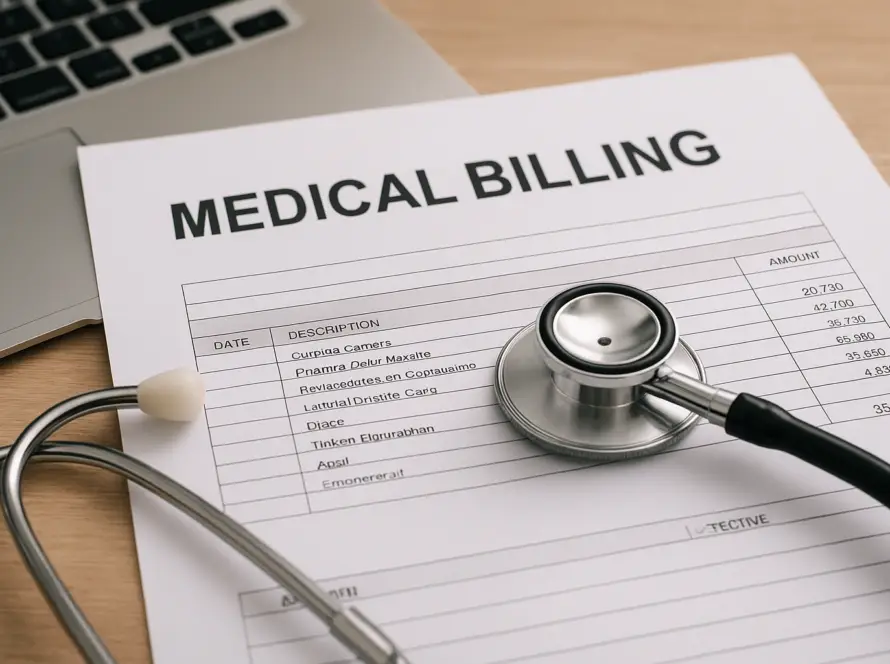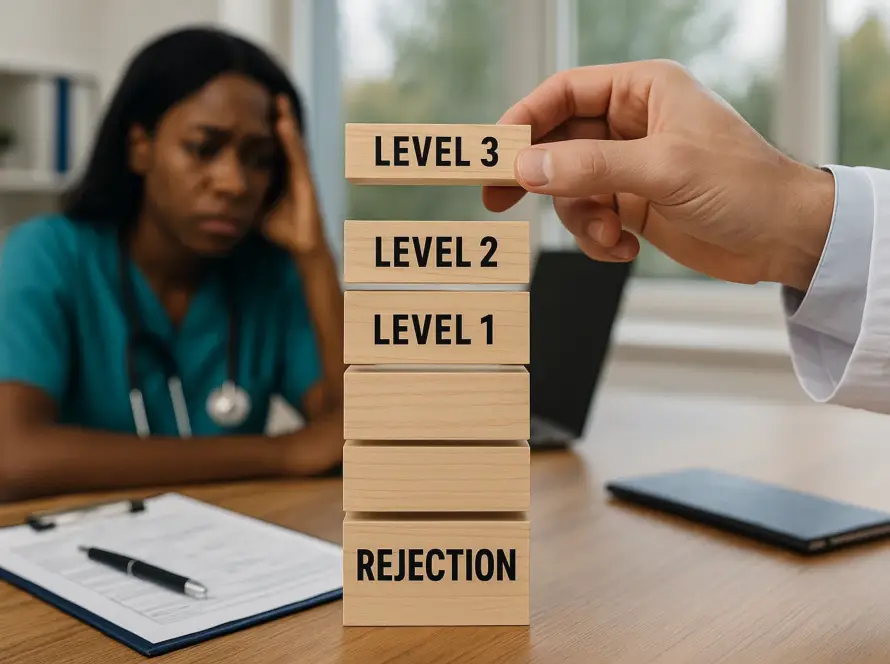Fake medical bills are becoming a growing concern for both patients and healthcare providers. With millions of claims processed daily, fraudsters often exploit confusion in billing systems to send false or misleading statements. These scams can lead to major financial losses, compliance issues, and broken patient trust. Identifying and preventing fake medical bills is essential for every healthcare organization. For patients, it protects their finances and personal data. For providers, it safeguards their reputation and ensures compliance with healthcare regulations.
Table of contents
Understanding Fake Medical Bills
Understanding what makes a medical bill “fake” is the first step toward protecting your practice and patients. Fraudulent billing often mimics real invoices, but subtle inconsistencies can reveal major red flags when reviewed carefully.
Definition & Key Characteristics
A fake medical bill is a fraudulent document that lists services or charges that were never provided. It may include stolen patient details, fake provider names, or exaggerated charges. These bills often look legitimate, using real logos or codes, making them difficult to detect without close review.
Typical warning signs include missing claim numbers, incorrect patient data, vague procedure descriptions, and direct payment requests from unknown billing entities. Every healthcare provider should verify such details before processing or paying any invoice.
Why Fraudsters Target Medical Bills
Medical billing fraud is attractive because of its complexity and volume. Patients rarely understand every charge, and providers process thousands of claims every month. This lack of transparency gives scammers opportunities to insert fake or modified bills without immediate detection.
Cybercriminals also target billing systems to access patient data and create believable invoices. Once fake bills are sent, even small payments made by victims can lead to repeated scams or identity theft.
Differences Between Legitimate Errors and Intentional Scams
Billing errors are common in healthcare but they differ from deliberate fraud. A legitimate error occurs when staff accidentally enter incorrect codes or duplicate a charge. These issues are usually resolved through clarification or a corrected claim.
Intentional scams, however, are designed to deceive. They include bills for unrendered services, inflated pricing, or fake provider information. The intent to defraud is a serious legal and ethical violation.
Healthcare organizations can minimize these risks by using medical billing services from Practice Perfect. Our expert team verifies claims for accuracy, audits data regularly, and helps providers detect fraudulent activity before it impacts revenue or compliance.
Red Flags That Indicate a Fake Medical Bill
Fraudulent bills often appear legitimate at first glance. However, there are key warning signs that can help you quickly identify a fake medical bill before it causes financial or data loss.
Unexpected Sender or Unknown Provider
One of the most common signs of a fake medical bill is receiving a statement from an unknown sender. Fraudsters often use unfamiliar provider names or third-party billing companies that patients have never visited.
Always verify the sender’s name, address, and contact number. If the bill doesn’t match your provider’s official details or contains generic email addresses, it’s likely a scam. Providers should ensure their patients know exactly who handles their billing to prevent confusion.
Missing or Inaccurate Insurance and Claim Details
A legitimate medical bill includes clear insurance information, claim numbers, service codes, and patient identifiers. Fake bills often omit these details or include vague, mismatched information.
If your insurance policy number is incorrect or the claim reference doesn’t align with recent visits, treat it as suspicious. Healthcare organizations can reduce these risks by implementing revenue cycle management services that ensure claim integrity and secure patient data.
Urgent Payment Demand Without Explanation
Scammers often pressure victims into making immediate payments by creating a sense of urgency. A fake medical bill may demand payment within 24–48 hours or threaten collections without proper justification.
Legitimate billing teams always provide a breakdown of charges, timelines, and a clear dispute process. Never make payments before verifying the authenticity of the bill directly with your provider or insurer.
How Patients Can Verify Their Medical Bills
Recognizing suspicious bills is important, but confirming authenticity is even more crucial. Patients can take a few practical steps to ensure that every medical charge is legitimate and properly billed.
Compare Bill with Your Explanation of Benefits (EOB)
Your Explanation of Benefits (EOB) from the insurance company is the first tool for verification. It outlines which services were billed, what was covered, and what you owe.
Compare every listed service and amount between your EOB and the medical bill. If a charge appears on the bill but not the EOB, it could signal a fake or duplicate charge.
👉 Read More About: What Happens If You Don’t Pay Medical Bills?
Check Dates, CPT/HCPCS Codes, and Services Provided
Each medical bill includes procedure codes (CPT or HCPCS) that represent specific services. Fake bills often contain incorrect, missing, or repetitive codes.
Patients should verify the accuracy of service dates, provider names, and procedure descriptions. If something seems inconsistent — like an appointment you didn’t attend, it’s best to question it before paying.
Contact the Provider or Insurer for Confirmation
If you’re uncertain about a bill’s legitimacy, contact your provider’s billing department or your insurance carrier directly. Never use contact numbers listed on the questionable bill, always call verified numbers from official websites or insurance cards.
Providers can protect their patients from scams by maintaining transparent billing communication and offering clear, accessible payment portals through secure systems.

How Providers Can Protect Their Practices from Fake Bills
Fake medical bills don’t just harm patients, they can also damage a provider’s reputation, revenue, and compliance standing. Building strong internal controls and working with verified billing experts is essential for long-term protection.
Secure Patient Data & Monitor Billing Channels
Cybercriminals often exploit unsecured communication systems or outdated billing software to steal patient information and issue fake invoices. Protecting sensitive data starts with encrypted billing portals, multi-factor authentication, and secure data storage systems.
Regularly reviewing billing communications helps ensure that only authorized personnel handle sensitive information. Monitoring every outgoing claim channel, from EHR exports to clearinghouse submissions, minimizes the risk of fraudulent activity.
Audit Claims Before Submission and Train Staff
Human errors are one of the most common entry points for billing fraud. Conducting routine internal audits before claim submission helps identify mismatched codes, duplicate charges, or unauthorized edits.
Training your billing staff on fraud indicators and proper claim verification ensures every submission meets payer and HIPAA standards. Empowering employees to report irregularities early can prevent costly denials or data breaches later.
Use Partnership with Trusted Billing Services
Partnering with an experienced billing service provider adds another layer of security and expertise. Professional billing partners use advanced compliance tools, secure claim submission systems, and continuous monitoring to detect unusual activity.
At Practice Perfect, our medical billing services are designed to protect your revenue cycle from fraud while improving accuracy, speed, and transparency. We manage everything from claim preparation to denial prevention, ensuring your billing operations remain compliant and fraud-free.
Best Practices for Both Patients & Providers to Prevent Billing Fraud
Fraud prevention is most effective when both patients and healthcare providers work together. Awareness, verification, and communication are the pillars of a safe, transparent billing environment.
Always Request Itemized Bills and Verify Details
Whether you’re a patient or provider, always request detailed itemized bills listing every service and charge. Reviewing the document line-by-line helps identify duplicate entries or procedures that weren’t actually performed.
Patients should never pay until they fully understand each line item, and providers should make these details easily accessible through clear, accurate billing documentation.
Set Up Alerts and Monitoring for Unusual Billing Patterns
Automated billing alerts and analytics tools can identify suspicious activities in real time. Providers can set triggers for duplicate charges or high-value transactions, while patients can monitor their insurance portals for unfamiliar claims.
Using secure, tech-enabled systems helps detect unusual billing behavior early and ensures timely action.
Report Suspected Fraud to Authorities & Stay Informed
If you suspect fraud, report it immediately to your provider, insurer, or the Office of Inspector General (OIG) at oig.hhs.gov. Reporting early not only protects your finances but also prevents larger-scale scams from spreading.
Staying informed about new fraud tactics, scam alerts, and compliance updates helps both patients and providers stay one step ahead of fraudulent activities.
Final Thoughts
Spotting a fake medical bill is not just about saving money, it’s about protecting your identity, your practice’s credibility, and the entire healthcare system. Fraudulent billing can drain resources, delay legitimate reimbursements, and expose both patients and providers to unnecessary stress and financial risk. By staying alert, verifying every detail, and using secure billing practices, both parties can maintain trust and transparency in the revenue cycle. Prevention starts with awareness and ends with action.
👉 Talk to a Medical Billing Expert today and protect your bottom line with confidence.
FAQs
A fake medical bill usually includes fabricated charges, incorrect patient details, or services never provided. These are often sent by scammers pretending to be real providers or collection agencies. Always verify the sender’s identity before making any payment.
Yes, never pay until you confirm its authenticity. Contact your healthcare provider or insurance company to verify if the claim exists. Paying a fake bill may result in financial loss and identity theft.
Providers should monitor claims through secure EHR systems, audit billing logs regularly, and restrict access to sensitive data. Automated alerts and claim-validation tools can flag inconsistencies early.
You can report suspected fraud to your insurer, healthcare provider, or directly to the US Department of Health & Human Services Office of Inspector General (OIG) via oig.hhs.gov. Acting quickly helps stop fraud before it spreads.




